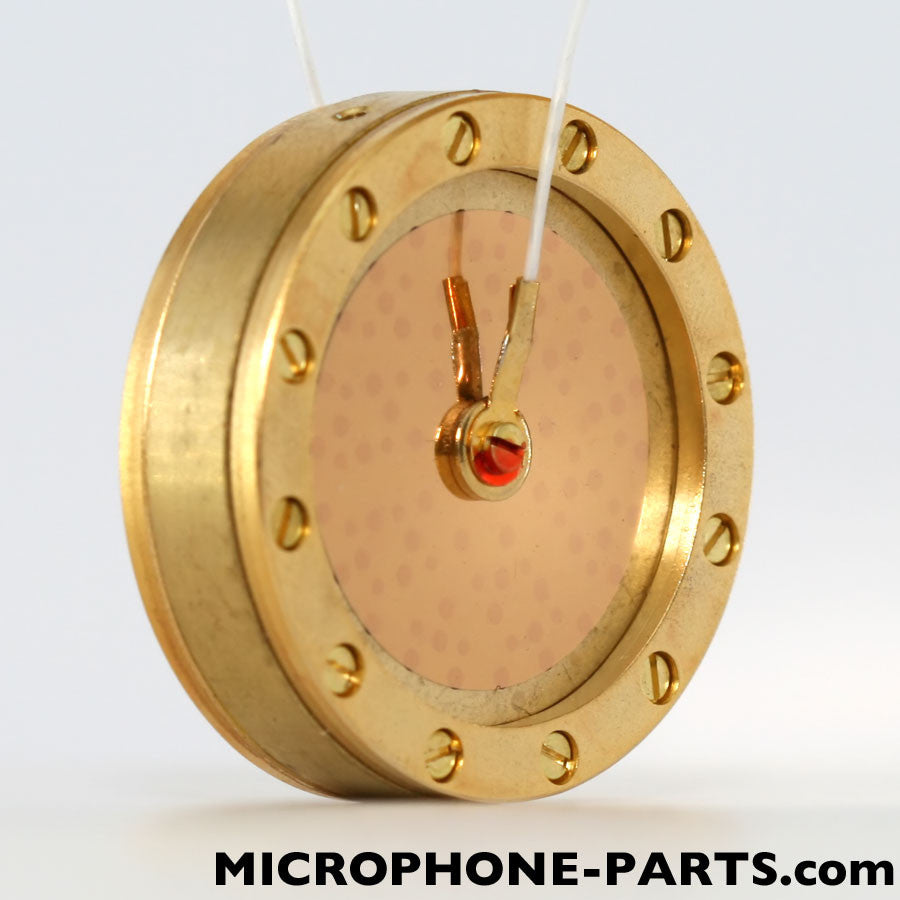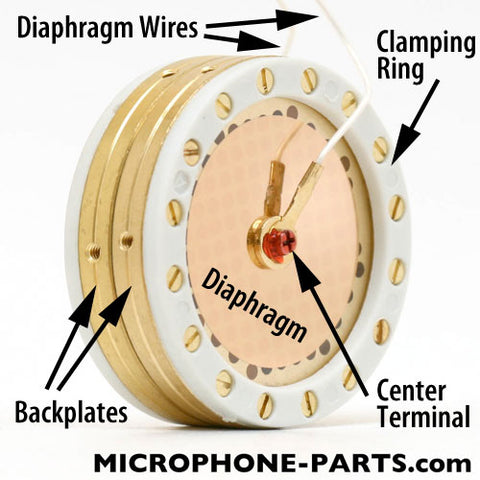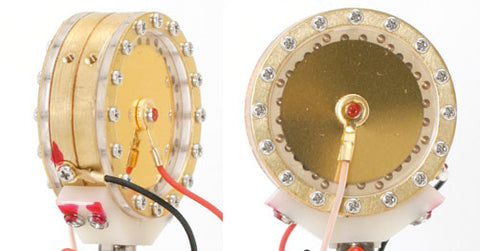Introduction to Condenser Capsule Upgrades
If you are new to DIY microphone upgrades, or need guidance in deciding which capsule to install in your microphone, this page will help.
It is intentionally long and detailed, because it attempts to be comprehensive. This page captures the 15-minute presentation required to answer the question "do you have any capsule mods for my mic that you've never heard of?" If that's your question, this page is your answer.
Capsule Types
MicParts sells three different large-diaphragm capsules that can be used to upgrade hundreds of different condenser mics. Here is an overview:
RK-47
|
Based on Neumann's K47. 34mm solid brass, single backplate, center-terminated. Brass clamping rings. Dual diaphragm. Compatible with Cardioid as well as multipattern microphones. Known for its "midrange presence" or "mid-forward" sound. Neutral top end. Good proximity effect. Neutral top end (not hyped). Works best with linear circuits (meaning, circuits that don't roll off the top two octaves). This is our most popular capsule for installation into inexpensive imported FET mics, and is our top recommendation for engineers who do not already own a K47-based condenser. |
RK-87
|
Based on Neumann's K67/K870. 34mm, dual brass backplates, center-terminated. Dual diaphragm. Insulated backplates (compatible with 4-wire mics). Compatible with Cardioid as well as multipattern microphones. We have tuned this capsule to have a milder high-frequency presence peak than do most K67s. This makes the RK-87 easier to use in DIY mic designs, because it requires less corrective EQ than would a traditionally-voiced K67. Further, because the RK-87 requires less HF rolloff, more "air" (20kHz response) is retained than can be had when using a more typical K67 voicing plus aggressive in-circuit EQ. This capsule, like all K67s, works best in a circuit that provides high-frequency corrective EQ, but can be used without in-circuit EQ when a bright/rising frequency response is desired. This capsule can be used as an upgrade for imported condensers (nearly all of which come with a very bright K67 variant), if the desire is to make the mic more usable and versatile without necessarily changing its voicing dramatically. |
RK-12
|
Based on AKG's CK-12. 34mm, dual backplates, edge-terminated. Dual diaphragm. Compatible with Cardioid as well as multipattern microphones. The RK-12 is known for its very smooth high-frequency response and full bass. It is our most popular capsule for vocal mics. It is our top recommendation for upgrading most Chinese-made vacuum tube microphones. This capsule can be used on linear circuits (without corrective EQ), or can be used with mild EQ to create a more neutral voicing. |
Capsule Terminology
| K67/K87 style (RK-87) | K47 Style (RK-47) | CK-12 Style (RK-12) |
 |
 |
 |
Capsule Compatibility
Before purchasing a capsule, ensure that it will work with your mic.
Electrical Compatibility
All MicParts large-diaphragm capsules require polarization voltage from the circuit. Generally speaking, any large-diaphragm condenser mic will provide polarization voltage; therefore, any true large-diaphragm condenser should be electrically compatible with all three MicParts large-diaphragm capsules.
Unfortunately, a few manufacturers misrepresent their products, claiming that the mics contain a large-diaphragm capsule when it isn't true. Therefore, you cannot trust your mic's original packaging or literature, but need to independently verify what is actually used in your mic.
One easy way to research your mic is to read about it in the RecordingHacks Mic Database [full disclosure -- we built that site before founding MicParts]. Capsule details for many hundreds of common inexpensive condenser mics are listed there.
If your mic's details are not found there, simply open up your mic to inspect the existing capsule.

The most commonly found large-diaphragm capsule in Chinese-made condensers is a 32mm variant of the K67. Pictured here is MXL's version of the K67. If your mic's capsule looks more or less like the capsule pictured at right, then it is safe to conclude that your mic has a large-diaphragm capsule, and can be upgraded with a MicParts capsule.

MXL makes several very popular mics that appear to be, and are sometimes described as "large diaphragm" mics when in fact they use a small-diaphragm capsules. The MXL 770 and 990 are common examples. The MXL 770/990 capsule is pictured at right. These mics are compatible with MicParts large-diaphragm capsules, and in fact MicParts' proprietary "supersaddle" is a drop-in upgrade/replacement for the MXL saddle, and affords very easy installation of a MicParts capsule into these microphones.

If your mic has a capsule like the one pictured at right, especially if the face of the capsule is smaller than 20mm in diameter, then it is probably an "electret" design. This is significant, because electrets do not require polarization voltage to work. Mics with electret capsules often do not provide polarization voltage; therefore, most electret-capsule mics are NOT compatible with MicParts' large-diaphragm capsules.
Many of Audio Technica's inexpensive mics use electret capsules, as well as proprietary mounts, making them poor candidates for DIY capsule upgrades.
Physical Fit
The second step in determining compatibility is to check for physical fit. In general, this is not an issue, because most large-diaphragm capsules measure 32-35mm in diameter, and nearly every mic that has room for a 32mm capsule will easily accommodate a 34mm capsule.
One exception we've seen is the GT55/ST55 series of mics from Groove Tubes and Sterling. These have a very narrow neck within the grille area. It can be filed to allow the RK-47 to fit. It is not likely that an RK-87 or RK-12 would fit. See more notes on this specific model here.
Installation Analysis
The final step in determining compatibility is to understand the installation process. For some microphones, installation is very easy; see the typical process here.
Several of the Chinese mic factories use the same style of capsule mounts. Installing a MicParts capsule into such mics is very easy; simply remove and replace the saddle, then install the new capsule. See sample instructions for this procedure here.
In other cases, the existing mount can be used. But every case is unique. If the donor mic had a 32mm or 35mm capsule, our 34mm capsules probably won't fit the existing saddle, because only one mounting screw hole is likely to line up. If you're installing an RK-47, its mounting holes almost certainly will not both line up with the holes in the existing saddle.
There are as many different solutions as there are donor microphones. If you're handy, you won't have any problem. We supply two different mounts with each capsule, in order to increase the likelihood that you have what you need to get the capsule into your microphone.
Capsule Choice and Voicing
Assuming your microphone can use a large diaphragm, true condenser capsule, and that you are confident you'll be able to install such a capsule, the next question is: which one?
These three capsule designs sound different, intentionally. All of them will make your microphone sound different -- because the capsule in any condenser determines 90-98% of the sound of the mic.
Chinese Mic Syndrome
Most cheap condensers are too bright / thin / shrill / hyped / sibilant for many sources. This is a result of a mismatch between capsule design (typically a K67) and circuit design (typically flat-response or linear with respect to frequency).
The use of a bright K67-style capsule with a flat-response circuit creates a sonic profile that is jarring and harsh. It can sound good on some sources, but creates ear fatigue over time, and causes problems at mix time (e.g. if all the tracks have a 5dB boost at 8-10kHz). We call this voicing the "Chinese mic syndrome." It's the reason MicParts was created: to provide alternative, better-sounding capsules to upgrade all those cheap condenser mics and make them usable.
Recommendations
The table at the top of this page summarizes the frequency profile of the three MicParts capsules. In addition to that, we can offer a few tips:
- For transformerless microphones, our top recommendation and most popular choice is the RK-47. Because transformerless mic circuits are nearly always linear (or essentially so), the RK-47 is a great choice. The RK-12 would work well too. The RK-87 would work for those cases where a subtler change from the stock voicing is desired. The RK-87 has better bass and a smoother top end than 32mm K67s that we've tested, and as such represents an audibly better choice than the stock capsule... but we prefer the RK-47 and RK-12, in that order.
- Transformer-coupled FET mics (such as the GXL3000, MXL 2001, MXL V67) can use any of the three capsules, but we prefer the RK-12 and RK-47, in that order.
- Tube microphones work well with both the RK-47 and RK-12, with the RK-12 being the most popular choice.
Why not another K67?
If your mic came from the factory with a K67, you might think that the most logical upgrade is to put another K67 in it. But you'd be assuming that the factory used that capsule design because it sounds good. It is more likely that your cheap mic was designed to hit a price point, not a target voicing. The K67 capsule is the least expensive of these three classic designs to manufacture. For many years, it was the only design being mass-produced in China. That's why it is the most common capsule found in inexpensive condenser mics.
To be sure, the RK-87 has a superior voicing to typical cheap K67s, for reasons explained above: the RK-87 has a milder high-frequency peak, and therefore needs less corrective EQ. In that sense, the RK-87 represents an upgrade for any 32mm K67 mic. But you'll probably find that the RK-12 and RK-47 are better choices.
A Note about Sonic Diversity
You don't want all your mics to sound the same. That's why we make 3 different capsule designs, and 3 different circuit topologies (transformerless JFET, transformer JFET, tube). Mix and match to create a mic locker that sounds great on every source in your studio.
